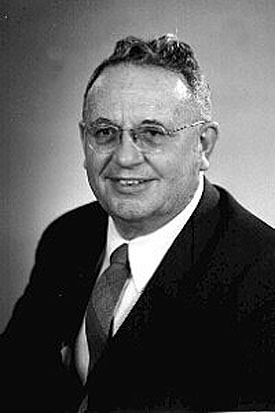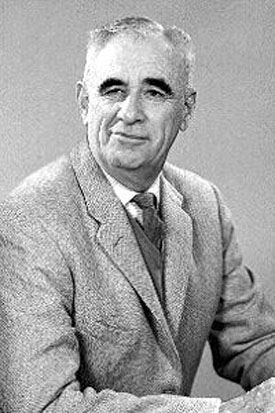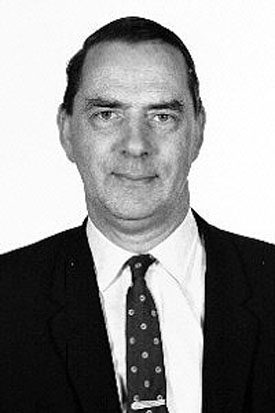CRC's Pioneers
F.T. Davies |
Frank T. DaviesFrank Davies was born in Wales in 1904 and came to Canada in 1925. Mr. Davies was a fellow of.the Royal Society of Canadai; a Governor of the Arctic Institute of North America, a member of the Antarctican Society of Washington, D.C., a member of the Canadian Association of Physicists and a former president of both the Arctic Circle Club of Ottawa and the Ottawa Welsh Society. Mr. Davies (Taffy) was physicist of the First Byrd Antarctic Expedition of 1928-30. He was awarded a Speciai United States Congressional Gold Medal which was presented by President Herbert Hoover in 1930. He was also awarded the Queen's Coronation Medal and Jubilee Medal far service to Canada. During the Second International Polar Year, Mr. Davies was Leader of the Canadian Expedition to the Arctic* for the Second International Year at Chesterfield Inlet in 1932-34. He was Director of the Carnegie Geophysical Observatory, Huan Cayo, in tbe Peruvian Andes 1936-39. He served in both British and Canadian Naval Intelligence during World War II. Seconded from National Research Council, he headed up an inter-service Section of the Royal Canadian Navy, concerned with the application of ionospheric data to communications, detection and direction finding in the HF band. From this Section evolved the Canadian Radio Wave Propagation Committee (CRWPC), c. 1944-1946, which formed the nucleus of the Radio Physics Laboratory (RPL), created by Defence Research Board in 1948, itself instituted in April 1948. Frank was Superintendent RPL 1948-1951, and Chief Superintendent the Defence Research Telecommunications Establishment (DRTE), except for a period when he was seconded to DRB/HQ, from 1951 until he retired in 1969. Mr. Davies was instrumental in the founding and
growth of research in the ionosphere, electronics and radio physics.
He died September 23, 1981 in Ottawa. Obituary. |
J.C.W. Scott |
James C.W. (Jim) Scott
Squadron Leader RCAF during WW II, member of initial small ionospheric group of the RCN in 1942. Early research studies as a member of the CRWPC included observation of 180 kHz Loran signals during the solar eclipse July 1945, and radio frequency prediction methods 1946-55. These early prediction methods were manual, based on nomograms, charts and graphs, but they are probably, still today, one of the better methods for predicting ionospheric propagation of HF radio frequencies in Canada. During 1955-59 Jim Scott was C/S DRTE while Frank Davies served in DRB/HQ. Member Canadian Joint Staff, London, UK 1959-63. Returned to DRTE to conduct independent theoretical research 1963 - 1969. Retired c. 1969. Member of the International Gravitation and General Relativity Society, and still pursuing his ideas* in that field at the age of 86. * Paper published in Nature, 25 February, 1967. |
J.H. Meek1
|
Jack H. MeekLt. RCN during WW II, initial member of the small group Section 6 of the Operational Intelligence Centre of the RCN, prior to its development into an inter-Service committee. While Davies and Scott were devising predictions methods, particularly long term, Dr. Meek was concerned with the methodology of forecasting ionospheric disturbances affecting radio wave propagation (1947-51). He was transferred to University of Saskatchewan, Saskatoon in 1951 where he conducted detailed studies on the correlation between magnetic, auroral and ionospheric variations, in an attempt to use magnetic variations as a precursor of ionospheric disturbance. Superintendent of the Communications Laboratory 1960- . After retirement in 1977 he returned to his first love, conducting upper atmosphere research at the Institute of Space and Technology, Tokyo, University of Tokyo and York University, Ontario. Dr. Meek died in California on October 12, 1983. |
J.W.
(Jim) Cox |
J.W. (Jim) Cox
From Marconi, UK, joined RPL in 1947, with a background
in radio and ionospheric research. Superintendent EL 1950 to about
1954, when he went to Cornell University for a year on staff, and
subsequently as senior DRB officer at Shape Air Defence Technical
Centre, Netherlands, for two years. He returned as Supt. EL for a
year, then became Director Physical Research (D Phy R) 1958-60. |
R.C. (Bob) Langille
|
R.C. (Bob) Langille
Dr. R.C. Langille was transferred to the
growing ionospheric section in 1946 from Army Operational Research,
and he expanded activities to continue the Army "Stormy Weather" Radar
Project. Both ionospheric and radar research developed to a point
at which DRB created the Radio Physics Laboratory on an Experimental
Farm site in 1948. Langille was at RPL 1947-1955, Assistant to
C/S 1955-1958, Superintendent EL 1958-1968, Director-General, DRTE
1969-1971, when he became Advisor on Space Policy to the Assistant
Deputy Minister, Space Programs. He also served as Director Physical
Research at DRB HQ for three years, and spent a year at National
Defence College.Dr. Langille died in Ottawa on May 6, 1985. |
Rita
Langille |
Rita Langille (née Richard)
Secretary to Frank T. Davies from the beginning,
1942 for the first 7 years, and so saw the growth of the small ionospheric
group under the RCN, to the much larger and expanding RPL, when she
became Mrs. R.C. Langille. |






